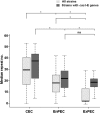CRISPR Content Correlates with the Pathogenic Potential of Escherichia coli
- PMID: 26136211
- PMCID: PMC4489801
- DOI: 10.1371/journal.pone.0131935
CRISPR Content Correlates with the Pathogenic Potential of Escherichia coli
Erratum in
-
Correction: CRISPR Content Correlates with the Pathogenic Potential of Escherichia coli.PLoS One. 2015 Jul 28;10(7):e0134138. doi: 10.1371/journal.pone.0134138. eCollection 2015. PLoS One. 2015. PMID: 26218764 Free PMC article. No abstract available.
Abstract
Guide RNA molecules (crRNA) produced from clustered regularly interspaced short palindromic repeat (CRISPR) arrays, altogether with effector proteins (Cas) encoded by cognate cas (CRISPR associated) genes, mount an interference mechanism (CRISPR-Cas) that limits acquisition of foreign DNA in Bacteria and Archaea. The specificity of this action is provided by the repeat intervening spacer carried in the crRNA, which upon hybridization with complementary sequences enables their degradation by a Cas endonuclease. Moreover, CRISPR arrays are dynamic landscapes that may gain new spacers from infecting elements or lose them for example during genome replication. Thus, the spacer content of a strain determines the diversity of sequences that can be targeted by the corresponding CRISPR-Cas system reflecting its functionality. Most Escherichia coli strains possess either type I-E or I-F CRISPR-Cas systems. To evaluate their impact on the pathogenicity of the species, we inferred the pathotype and pathogenic potential of 126 strains of this and other closely related species and analyzed their repeat content. Our results revealed a negative correlation between the number of I-E CRISPR units in this system and the presence of pathogenicity traits: the median number of repeats was 2.5-fold higher for commensal isolates (with 29.5 units, range 0-53) than for pathogenic ones (12.0, range 0-42). Moreover, the higher the number of virulence factors within a strain, the lower the repeat content. Additionally, pathogenic strains of distinct ecological niches (i.e., intestinal or extraintestinal) differ in repeat counts. Altogether, these findings support an evolutionary connection between CRISPR and pathogenicity in E. coli.
Conflict of interest statement
Figures




Similar articles
-
Clustered, regularly interspaced short palindromic repeat (CRISPR) diversity and virulence factor distribution in avian Escherichia coli.Res Microbiol. 2017 Feb-Mar;168(2):147-156. doi: 10.1016/j.resmic.2016.10.002. Epub 2016 Oct 24. Res Microbiol. 2017. PMID: 27789334
-
Polymorphism of CRISPR shows separated natural groupings of Shigella subtypes and evidence of horizontal transfer of CRISPR.RNA Biol. 2015;12(10):1109-20. doi: 10.1080/15476286.2015.1085150. Epub 2015 Sep 1. RNA Biol. 2015. PMID: 26327282 Free PMC article.
-
Survey of clustered regularly interspaced short palindromic repeats and their associated Cas proteins (CRISPR/Cas) systems in multiple sequenced strains of Klebsiella pneumoniae.BMC Res Notes. 2015 Aug 4;8:332. doi: 10.1186/s13104-015-1285-7. BMC Res Notes. 2015. PMID: 26238567 Free PMC article.
-
History of CRISPR-Cas from Encounter with a Mysterious Repeated Sequence to Genome Editing Technology.J Bacteriol. 2018 Mar 12;200(7):e00580-17. doi: 10.1128/JB.00580-17. Print 2018 Apr 1. J Bacteriol. 2018. PMID: 29358495 Free PMC article. Review.
-
Approaches to study CRISPR RNA biogenesis and the key players involved.Methods. 2020 Feb 1;172:12-26. doi: 10.1016/j.ymeth.2019.07.015. Epub 2019 Jul 17. Methods. 2020. PMID: 31325492 Review.
Cited by
-
The CRISPR conundrum: evolve and maybe die, or survive and risk stagnation.Microb Cell. 2018 May 16;5(6):262-268. doi: 10.15698/mic2018.06.634. Microb Cell. 2018. PMID: 29850463 Free PMC article. Review.
-
CRISPR1 analysis of naturalized surface water and fecal Escherichia coli suggests common origin.Microbiologyopen. 2016 Jun;5(3):527-33. doi: 10.1002/mbo3.348. Epub 2016 Mar 22. Microbiologyopen. 2016. PMID: 27004771 Free PMC article.
-
Two multidrug-resistant Proteus mirabilis clones carrying extended spectrum beta-lactamases revealed in a single hospital department by whole genome sequencing.Heliyon. 2024 Nov 29;10(23):e40821. doi: 10.1016/j.heliyon.2024.e40821. eCollection 2024 Dec 15. Heliyon. 2024. PMID: 39687096 Free PMC article.
-
Correction: CRISPR Content Correlates with the Pathogenic Potential of Escherichia coli.PLoS One. 2015 Jul 28;10(7):e0134138. doi: 10.1371/journal.pone.0134138. eCollection 2015. PLoS One. 2015. PMID: 26218764 Free PMC article. No abstract available.
-
DNA-Sequence Based Typing of the Cronobacter Genus Using MLST, CRISPR-cas Array and Capsular Profiling.Front Microbiol. 2017 Sep 29;8:1875. doi: 10.3389/fmicb.2017.01875. eCollection 2017. Front Microbiol. 2017. PMID: 29033918 Free PMC article.
References
-
- Mojica FJM, Díez-Villaseñor C, Soria E, Juez G (2000) Biological significance of a family of regularly spaced repeats in the genomes of Archaea, Bacteria and mitochondria. Mol Microbiol 36: 244–246. - PubMed
-
- Jansen R, Embden JD, Gaastra W, Schouls LM (2002) Identification of genes that are associated with DNA repeats in prokaryotes. Mol Microbiol 43: 1565–1575. - PubMed
-
- Mojica FJM, Ferrer C, Juez G, Rodríguez-Valera F (1995) Long stretches of short tandem repeats are present in the largest replicons of the Archaea Haloferax mediterranei and Haloferax volcanii and could be involved in replicon partitioning. Mol Microbiol 17: 85–93. - PubMed
Publication types
MeSH terms
Substances
LinkOut - more resources
Full Text Sources
Other Literature Sources
Molecular Biology Databases

